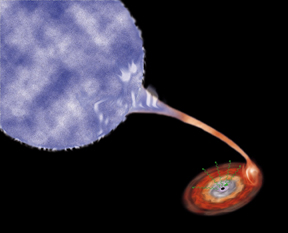RXTE Discoveries
RXTE Discovers High Frequency QPOs - August 1996
The Rossi X-ray Timing Explorer (RXTE) has discovered neutron stars that emit streams of X-rays that pulse over 1,000 times a second. The pulses are not strictly periodic, but vary slightly from cycle to cycle. Astronomers call them "quasi-periodic oscillations" or QPOs. This just means that the pulses are almost, but not quite, periodic.
 |
A neutron star is the superdense remains of an exploded star that gravitationally collapsed back in on itself to form a small, compressed core of neutrons. It is not unusual for a neutron star to emit X-rays. When a neutron star is in a binary system with a sun-like star, matter is gravitationally pulled off this stellar companion. As the matter falls toward the neutron star, it emits X-rays. As UC Berkeley astrophysicist Jonathan Arons said "It's the sound of matter going splat."
|
Sometimes the emitted X-rays are pulsed, or modulated by the spinning of the neutron star. The pulse period seen in the X-ray emission is exactly the same as the spin period of the star. However, another type of pulsation, the QPO, was found in the mid-1980s by the European X-ray Observatory Satellite (EXOSAT). The cycle times of these QPO's were between 6 and 20 times a second for most of the sources in which this behavior was observed. It was also noticed that the average period of the oscillations varied as the overall X-ray brightness of the source varied. The brighter the source was in X-rays, the shorter the QPO period. Scientifically, this means that the central frequency varies as source intensity.
It was theorized that this modulation of X-rays was due to the difference in frequency between the matter's orbital period around the neutron star and the spin period of the neutron star. This difference is called the beat frequency.
The beat frequency is important. The neutron star and the matter orbiting it move at different rates. For the matter to be able penetrate the neutron star's magnetosphere to cause the QPO, the matter has to be at the right place at the right time. This only occurs at the beat frequency. (see diagram below. Diagram is based on a drawing originally done by Michiel van der Klis and published in Exploring the X-ray Universe by Philip Charles and Frederick Seward (1995). Used by permission.)
The beat frequency model would also explain the 6-20 Hz QPOs that EXOSAT observed. Until RXTE, it was hard to confirm this theory, because most of the systems in which QPO's occur did not allow for direct measurement of the neutron star spin period.
Because of its much higher sensitivity and time resolution, RXTE has not only discovered QPOs at much higher frequencies than 6-20 Hz, it may also have verified the "beat frequency" model. RXTE has directly observed the neutron star spin frequency, the frequency of the orbiting material, and the beat frequency for a particular X-ray source. This source, named 4U 1728-34, has a neutron star rotation frequency of 363 Hz. The frequency of the orbiting material is around 1100 Hz, and the beat frequency, or difference between the two, is around 700 Hz; this is what theory predicts.
As an alternative explanation to the beat frequency theory, some scientists now speculate that these rapid QPOs are caused by hot bubbles of radiation bursting on the neutron star's surface and colliding with the infalling matter.
As RXTE continues to observe the high-energy universe over the years to come, astronomers hope to get the data which will not only allow them to understand what is happening, but why, and how.


